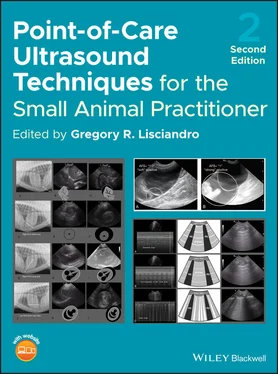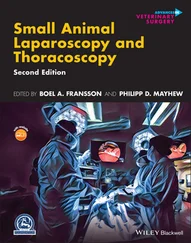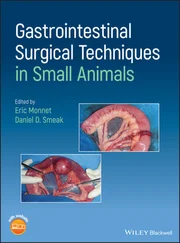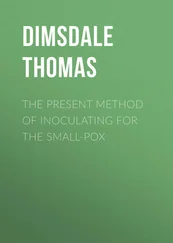50 Mandell DC, Drobatz K. 1995. Feline hemoperitoneum 16 cases (1986–1993). J Vet Emerg Crit Care 5(2):93–97.
51 Marshall KA, Thomovsky EJ, Brooks AC, et al. 2018. Ultrasound measurements of the caudal vena cava before and after blood donation in 9 greyhound dogs. Can Vet J 59(9):973–980.
52 Matsushima K, Frankel HL. 2011. Beyond focused assessment with sonongraphy for trauma: ultrasound creep in the trauma resuscitation area and beyond. Curr Opin Crit Care 17(6):606–612.
53 McMurray J, Boysen S, Chalhoub S. 2016. Focused assessment with sonography in nontraumatized dogs and cats in the emergency and critical care setting. J Vet Emerg Crit Care 26(1):64–73.
54 Mohammadi A, Ghasemi‐Rad M. 2012. Evaluation of gastrointestinal injury in blunt abdominal trauma “FAST is not reliable”: the role of repeated ultrasonography. World J Emerg Surg 7(1):2.
55 Muir W. 2006. Trauma: physiology, pathophysiology, and clinical implications. J Vet Emerg Crit Care 16(4):253–263.
56 Narasimhan M, Koenig SJ, Mayo PH. 2016. A whole‐body approach to point of care ultrasound. Chest 150(4):772–776.
57 Nelson NC, Drost WT, Lerche P, et al. 2010. Noninvasive estimation of central venous pressure in anesthetized dogs by measurement of hepatic venous blood flow velocity and abdomen al venous diameter. Vet Radiol Ultrasound 51(3):313–323.
58 Ollerton JE, Sugrue M, Balogh Z, et al. 2006. Prospective study to evaluate the influence of FAST on trauma patient management. J Trauma 60:785–791.
59 Perera P, Mailhot T, Riley D, et al. 2010. The RUSH exam: Rapid Ultrasound in SHock in the evaluation of the critically ill. Emerg Med Clin North Am 28(1):29–56.
60 Pintar J, Breitschwerdt EB, Hardie EM, et al. 2003. Acute nontraumatic hemoabdomen in the dog : a retrospective analysis of 39 cases (1987–2001). J Am Anim Hosp Assoc 37:518–522.
61 Quantz JE, Miles MS, Reed AL, et al. 2009. Elevation of alanine transaminase and gallbladder wall abnormalities as biomarkers of anaphylaxis in canine hypersensitivity patients. J Vet Emerg Crit Care 19(6):536–544.
62 Robinson DA, Kiefer K, Bassett R, et al. 2016. Autotransfusion in dogs using a 2‐syringe technique. J Vet Emerg Crit Care 26(6):766–774.
63 Romero LA, Lisciandro GR, Fosgate GT, et al. 2015. Abdominal FAST (AFAST) and abdominal fluid scores in adult and juvenile dogs. Abstract. J Vet Emerg Crit Care 25(S1):S7–S8.
64 Rozycki GS. 1998. Surgeon performed US: its use in clinical practice. Ann Surg 228:16–28.
65 Rozycki GS, Ballard RB, Feliciano DV, et al. 1998. Surgeon‐performed ultrasound for the assessment of truncal injuries: lessons learned from 1540 patients. Ann Surg 228(4):557–567.
66 Rozycki GS, Pennington SD, Feliciano DV. 2001. Surgeon‐performed ultrasound in the critical care setting: its use as an extension of the physical examination to detect pleural effusion. J Trauma 50(4):636–42.
67 Sgourakis G, Lanitis S, Zacharioudakis C, et al.2012. Incidental findings in trauma patients during focused assessment with sonography for trauma. Am Surg 78(3):366–72.
68 Shaw S, Rush JE. 2007. Canine pericardial effusion: pathophysiology and cause. Compendium 29(7):400–404.
69 Simons FER, Ebisawa M, Sanchez‐borges M, et al. 2015. 2015 update of the evidence base: World Allergy Organization anaphylaxis guidelines. World Allergy Organ J 8:32.
70 Sobrino J, Shafi S. 2013. Timing and causes of death after injuries. Proc (Bayl Univ Med Cent) 26(2):120–123.
71 Stafford Johnson M, Martin M, Binns S, et al. 2004. A retrospective study of clinical findings, treatment and outcome in 143 dogs with pericardial effusion. J Small Anim Pract 45(11):546–552.
72 Tchernodrinski S, Arntfield R. 2015. Inferior vena cava. In: Point‐of‐care Ultrasound, edited by Soni NJ, Arntfield R, Kory P. Philadelphia: Elsevier/Saunders, pp 135–144.
73 Tuplin MC, Romero AE, Boysen SR. 2017. Influence of the respiratory cycle on caudal vena cava diameter measured by sonography in healthy foals: a pilot study. J Vet Intern Med 31(5):1556–1562.
74 Udobi KF, Rodriguez A, Chiu WC et al. 2001. Role of utrasonography in penetrating abdominal trauma: a prospective study. J Trauma 50:475–479.
75 Walker T, Tidwell AS, Rozanski EA, et al. 2005. Imaging diagnosis: acute lung injury following massive bee envenomation in a dog. Vet Radiol Ultrasound 46(4):300–303.
76 Ward JL, Lisciandro GR, Ware WA, et al. 2018. Evaluation of point‐of‐care thoracic ultrasound and NT‐proBNP for the diagnosis of congestive heart failure in cats with respiratory distress. J Vet Intern Med 32(5):1530–1540.
1 Boston SE, Higginson G, Monteith G. 2011. Concurrent splenic and right atrial mass at presentation in dogs with HSA: a retrospective study. J Am Anim Hosp Assoc 47(5):336–341.
2 Grimes JA, Fletcher JM, Schmiedt CW. 2018. Outcomes in dogs with uroabdomen: 43 cases (2006–2015). J Am Vet Med Assoc 252(1):92–97.
3 Hoffberg JE, Koenigshof AM, Guiot LP. 2016. Retrospective evaluation of concurrent intra‐abdominal injuries in dogs with traumatic pelvic fractures: 83 cases (2008–2013). J Vet Emerg Crit Care 26:288–294.
4 Kim SY, Park KT, Yeon SC, et al. 2014. Accuracy of sonographic diagnosis of pneumoperitoneum using the enhanced peritoneal stripe sign in beagle dogs. J Vet Sci 15(2):195–198.
5 Kolata RJ, Dudley EJ. 1975. Motor vehicle accidents in urban dogs: a study of 600 cases. J Am Vet Med Assoc 167:938–941.
6 Mongil CM, Drobatz KJ, Hendricks JC. 1995. Traumatic hemoperitoneum in 28 cases: a retrospective review. J Am Anim Hosp Assoc 31:217–222.
7 Sigrist NE, Adamik KN, Doherr MG, et al. 2011. Evaluation of respiratory parameters at presentation as clinical indicators of the respiratory localization in dogs and cats with respiratory distress. J Vet Emerg Crit Care 21(1):13–23.
8 Simpson SA, Syring R, Otto CM. 2009. Severe blunt trauma in dogs: 235 cases (1997–2003). J Vet Emerg Crit Care 19(6):588–602.
Chapter Eight POCUS: Liver and Gallbladder
Stephanie C. Lisciandro, Jennifer M. Gambino, and Sarah Young
The goals of using POCUS for evaluation of the liver include recognizing focal and multifocal mass lesions and evaluating diffuse parenchymal echotexture and obvious changes in echogenicity. Evaluation for hepatic venous congestion may also be accomplished. The goals for the POCUS examination of the gallbladder include recognizing gallbladder wall abnormalities, luminal disease processes (e.g., accumulation of echogenic debris and wall nodules or mass lesions), and identification of signs that may support biliary obstruction. The POCUS liver and gallbladder examination can help guide clinical decisions by providing initial information that may not otherwise be evident with radiography.
The POCUS liver and gallbladder examination does not replace a complete detailed abdominal ultrasound study by a veterinarian with advanced training (veterinary radiologist or internist). The use of the POCUS examination may direct the clinician to obtain a complete study since the comprehensive evaluation of the liver and biliary tract is inherently more technically challenging for the novice sonographer than other abdominal organs. It is especially important to note that an unremarkable POCUS liver and gallbladder examination does not rule out the possibility of significant hepatobiliary dysfunction and disease. Liver biopsy may still be indicated when there is evidence of hepatic dysfunction, even with a lack of ultrasound abnormalities.
AFAST and the abdominal fluid scoring system (better the Global FAST approach) should be performed in conjunction with all POCUS abdominal exams, so as not to miss abdominal and retroperitoneal effusion including peritonitis and hemorrhage. Global FAST would be an even better approach to survey for pleural and pericardial effusion, and obvious cardiac and pulmonary abnormalities, and Global FAST is used as a screening test to rapidly discriminate between localized versus disseminated disease and identify complicating comorbidities.
Читать дальше












